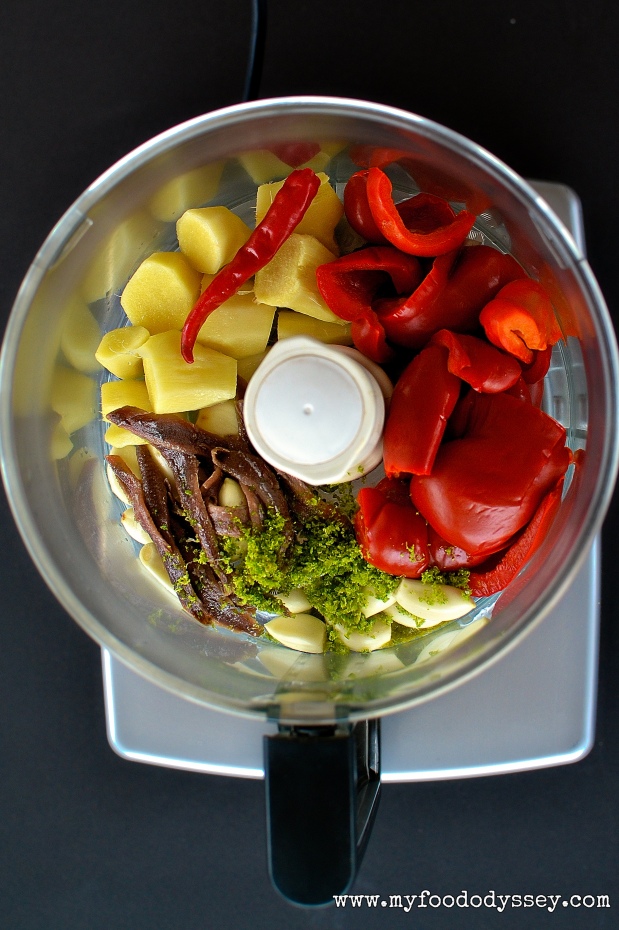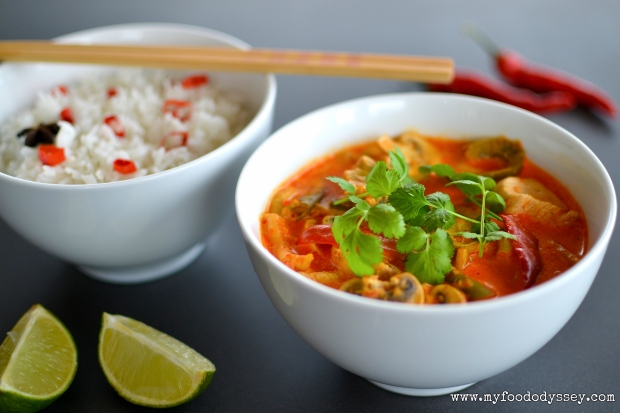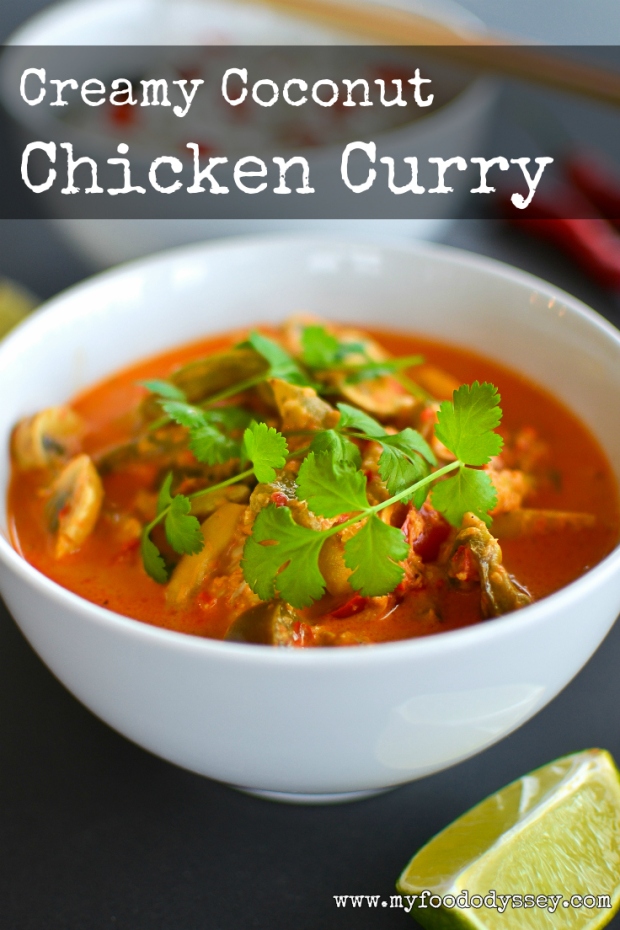Thai Chicken Curry [Recipe]

I love Thai food. It is a feast for the senses – fragrant and aromatic with a heady mix of spices, a touch of heat and a balance of flavour across sweet, sour, salty and savoury (umami) . It is vibrant and colourful, with fresh vegetables and herbs just as important as the meat or fish component. And it uses a variety of textures, from crunchy vegetables to soft meat and sticky rice.
Thai food has become very popular in western countries and you can easily buy Thai curry paste, fish sauce (nam pla), coconut milk and a wide variety of herbs and spices in your supermarket. However, the pastes you buy do not even come close to the punch of flavour from a homemade paste. Making the paste does take a little time, but there isn’t much to it apart from some peeling, grinding and grating. For the most part it uses ingredients that are pantry staples – it is the number of ingredients that makes it look complex.
Making your paste at home also allows you to tailor the taste to your own preferences and to the ingredients you have available. Lemongrass would typically be used in a Thai curry paste. I have trouble finding lemongrass in my local supermarket and if it is available it tends to be expensive, so I use lots of lime juice and zest instead. If you can’t get limes, lemons make a good alternative.
Arūnas is not a big fan of chilli heat, so I use just one cayenne chilli. I grow these myself and know how hot they are. Cayenne are a mid-heat chilli. If you’re using a milder chilli such as jalapeno, you might want to use more than one. If you’re using a very hot chilli such as scotch bonnet, you might want just a small piece. The key is to taste your chillies and add more gradually. Try to cater for those with the lowest heat tolerance. You can always serve sliced fresh chilli or dried chilli flakes at the table for those who like extra heat.
White pepper is more common than black pepper in Thai cooking as it has a gentler flavour and doesn’t leave dark flecks in the finished sauce. However, using black pepper as an alternative will not greatly alter the dish. Fennel seeds are a good alternative if you don’t have caraway seeds. Use cinnamon powder as an alternative to cinnamon bark. If you don’t have one or two of the spices don’t worry – the final dish will still be delicious without them.
The quantities of ginger and garlic look massive, but don’t stint on these. The finally curry does not taste significantly of either, but you need this quantity to get a deeply fragrant and flavourful dish. Low fat coconut milk does not have the same luxurious flavour as full fat milk and tends to be more fluid in consistency. I recommend using full fat creamy coconut milk for best results, but use whichever you prefer or have to hand.
Despite the long list of ingredients, this curry is incredibly easy to prepare. The dish itself comes together in less than 15 minutes. If you make the paste a day or two in advance and store it in the fridge, you can have the vegetables prepared, the rice cooked and a delicious, homemade curry on the table in less than half an hour.
Thai Chicken Curry
INGREDIENTS:
For the curry paste:
-
2 tsp coriander seeds
1 tsp caraway seeds
1 tsp white peppercorns
1 tsp yellow mustard seeds
½ tsp cumin seeds
4 cm | 1.5 in sliver of cinnamon
2 cloves
1½ heads garlic (about 20 cloves)
2 big thumbs of ginger (about 100g | 3.5 oz)
1 medium cayenne chilli (or more to taste)
2 roasted or marinated red peppers (about 200g | 7 oz)
1 x 50g | 2 oz tin salted anchovies in oil
2 limes, juice and finely grated zest
3 Tbsp rapeseed (canola) or sunflower oil
For the curry:
-
1 red pepper
1 green pepper
10 button mushrooms (about 200g | 7 oz)
250 | 9 oz green beans (string beans)
600 g | 1 lb 5 oz skinless, boneless chicken breast (about 4 small chicken breasts)
400 ml | 13.5 oz tin coconut milk
4 tsp cornflour or potato starch
3 Tbsp cold water
For the rice:
-
300 g | 10 oz basmati rice
1 tsp salt
1 star anise
700 ml | 1.5 pints boiling water
To serve:
-
Bunch fresh coriander (cilantro), washed and roughly chopped
Thai fish sauce (nam pla), to taste.
METHOD:
- Put the coriander seeds, caraway seeds, peppercorns, mustard seeds, cumin seeds, cinnamon and cloves into a pan set over a high heat. Toast the spices, stirring occasionally, until they start to smoke and the mustard seeds start to pop – about 5 minutes.
- Tip the spices into a mortar or electric spice grinder and grind to a rough powder. Pay particular attention to the cinnamon and cloves.
- Peel the ginger and cut into chunks. Peel the garlic cloves. Remove the stalk end from the chilli.
- Place the ginger, garlic, chilli, anchovies (including their oil), roasted or marinated peppers, lime juice, lime zest, rapeseed oil and ground spices into a food processor or blender. Blend for one minute. Scrape down the sides with a spoon or spatula and blend again for 1 minute. The paste may have a slightly rough texture – this is fine as long as there are no significant lumps.
You can make the paste a day or two in advance and store in a jar in the fridge. If storing for more than a few days, pour a thin layer of rapeseed oil over the surface of the paste to keep out any air. - Prepare the vegetables. Deseed the peppers and cut into bite-sized pieces. Wash and slice the mushrooms. Wash the green beans and cut into 2 cm (1 inch) lengths.
- Cut the chicken into bite-sized pieces – about 2 cm (1 inch) cubes.
- Put all of the curry paste into a large saucepan over a gentle heat. Cook the paste, stirring continuously, for about 2 minutes.
- Add the coconut milk, chicken and vegetables and stir well to combine. Bring the sauce to the boil, then reduce to a low heat and simmer for 10 minutes or until the chicken is cooked through. (Test by removing one piece of chicken and cutting in half. It should be fully white inside, with no signs of pink.)
- While the curry is simmering, prepare the rice. Place the rice, salt and star anise in a medium saucepan. Add the boiling water and place the saucepan over a high heat. Bring the water back to the boil, then reduce the heat to low, cover with a lid and simmer gently for 10 minutes. At the end of cooking time, remove the lid and stir the rice with a fork to fluff it up and allow steam to escape.
- Depending on the creaminess of your coconut milk and the water content of the vegetables, the final curry can be quite soupy in consistency. Sometimes I like this, and enjoy the curry as a soup, a bit like a laksa. Other times I prefer a thicker consistency that sits nicely on top of a bed of rice. To thicken the sauce, mix 4 teaspoons of cornflour or potato starch with 3 tablespoons of cold water in a cup. While the sauce is simmering, add the starch mixture a little at a time, stirring well between each addition until the sauce reaches your desired consistency.
- Serve topped with a generous sprinkle of coriander (cilantro) and fish sauce on the side.
Like what you see? Then please subscribe to My Food Odyssey. For updates on my daily life you can follow me on Facebook, Twitter and Pinterest.
Disclosure: This post is not sponsored in any way. It does contain links to products that I have personally selected and recommend. If you purchase products via the links in this post I receive a teeny, tiny commission.





































I love Thai food! thank you for sharing, June 🙂
LikeLiked by 1 person
I’m saving this one.
LikeLike
As usual June, a great article.
LikeLiked by 1 person
Looks wonderful. I was thinking about growing some chilis this year. Any idea if we can grow ginger in this climate? Thanks for posting the recipe, I’ll give it a shot later this week. 🙂
LikeLiked by 1 person
Not sure about ginger, Susan – I’ve never looked into it. You’ll definitely grow chillies in your greenhouse, though!
LikeLike
Bookmarked! I love Thai food too, and will definitely try out your recipe.
LikeLiked by 1 person
Stunning June! I agree you can’t get the same depth of flavour from a ready made curry paste.
LikeLiked by 1 person
Thanks Donna! Your veggie curry looks yummy – I must give that a go soon!
LikeLike
I am so in.
LikeLiked by 1 person
We have just found an amazing middle eastern spice store right next door to a fabulous Asian shop. So, psychic June you have published this at the exact moment that I am full of enthusiasm to create some pastes and spice mixes. I’m going in!
LikeLiked by 1 person
You won’t regret it, Osyth! Prepare for a flavour explosion!
LikeLiked by 1 person
🙂
LikeLiked by 1 person
Beautiful pictures!
LikeLiked by 1 person
looks great thanks for sharing 🙂
LikeLiked by 1 person